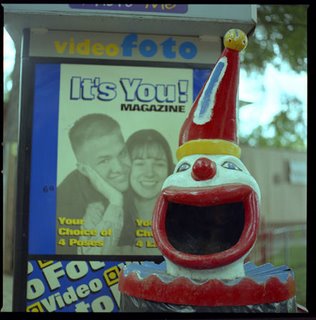
My wife Jennifer is a fine art photographer who works in chromagenic printing, which was the dominant form of color photography prior to recent advances in digital technology. The primary goal of chromagenic printing is to minimize one's exposure to toxic chemicals while producing images that are of a character quite different from that of digital photography. While many commercial and fine art photographers made the leap to digital and never looked back, Jennifer decided to take a different path, one that has defined her subsequent career and will continue to do so for the forseeable future. As a consequence of that conscious choice, she has found herself increasingly working as a preservationist and an advocate of the craft of photographic printing in a field that is undergoing a technological revolution. It has, so far, been an interesting place to be.
Modern color darkrooms depend on expensive processors which contain the chemicals and limit photographers' exposure; combined with additional requirements of ventilation and temperature control, the constraints make establishing and running a color darkroom for medium- or large-scale printing far more expensive than a black-and-white darkroom that can be set up in an apartment bathroom. As a result, the artist's independence in producing color photography on the scale favored by most galleries is far more limited than in black-and-white work. A few highly successful color photographers have built their own darkrooms, but emerging and even mid-career photographers have relied on rental darkrooms. But as casual photographers have embraced the ease of use and versatility of digital photography, these businesses have struggled to adapt and many have converted entirely to digital labs.
Since graduating from the San Francisco Art Institute in 2001, Jennifer has located less than six color darkrooms available for rental in the United States, and has traveled to San Francisco and Seattle to print twice a year since moving to Texas in 2002. (In San Francisco, she prints at SFAI, which welcomes her as an alumnus; in Seattle, she prints at the Pacific Northwest Center for Photography, which awarded her one of the center's first printing scholarships in 2005.)
Dependent on key manufacturers for her materials, she has watched the news as film companies have disbanded, specialty papers have ceased production, and photo industry leaders like Kodak ignored digital photography at their peril, then attempt dramatic corrections by abandoning many of their analog products altogether. It is a surreal experience, akin to a ceramicist following the news to learn when the last of the world's clay will be all used up.
Our belief is that the decline of the traditional photographic industry will reach a plateau, that specialized uses for negative film, photographic paper, and analog cameras will survive the cataclysm, and that the art world will continue to recognize the medium's value, just as black-and-white photography survived the coming of high-quality color printing decades ago.
We also believe, and are proof enough, that as the industry sheds its skin a historic window of opportunity has opened up for young photographers interested in preserving this method of printing, and that the world of analog photography will turn more or less upside down as the major players abandon the format. For those willing to accept the medium's new challenges - equipment maintenance in the face of diminishing outside expertise, the "antique" parts market that is sure to develop as more and more machines go out of commission, the increasing cost of film or paper or difficult decisions made in the face of a narrowing field of choices - much of the expensive infrastructure of the traditional darkroom is turning up on eBay auctions and reseller sites for a fraction of its original cost.
With this in mind, we have decided to build an analog color darkroom. We have no experience in doing this, and thought it would be interesting to document our learning process. This blog will be that document.